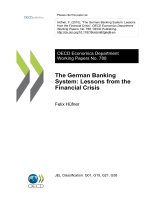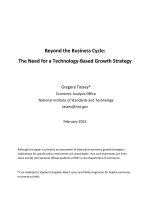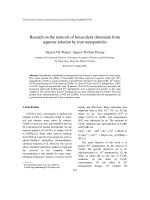Beyond the zulu principle extraordinary profits from growth shares by jim slater
Bạn đang xem bản rút gọn của tài liệu. Xem và tải ngay bản đầy đủ của tài liệu tại đây (3.72 MB, 211 trang )
Table of Contents
Cover
Publishing details
Acknowledgements
Preface to the 1996 Edition
Preface to the 2010 Edition
1. Your Approach to Investment
Aim to beat the institutions
Investment clubs
The Zulu Principle
Reading about investment
Company REFS
Summary
2. Why Growth Shares?
The main approaches to investment
A remarkable investor
Some UK examples
The case for growth shares
The market as a whole
Selection is more important than timing
Summary
3. What is a Growth Share?
The Right Sectors
Competitive advantage
Management
Earnings per share growth
Company REFS’ definition
Summary
4. Price-Earnings Growth Factors
Compare chalk with chalk
Rolling twelve months ahead
Checking the validity of forecasts
Brokers’ consensus forecasts
Summary
5. PEGs at Work
PEG tests
Avoid shares on very high PERS
Summary
6. Cash Flow
Advantages of strong cash flow
Constructing a cash flow sieve
Capital expenditure
Summary
7. Relative Strength
The third sieve
Further proof
More on relative strength
Technical analysis
Summary
8. Management
Ways of checking management
Chief executive officer changes
Directors’ share dealings
Summary
9. Competitive Advantage
The right sector
The key statistics
Return on capital employed
Exclusion of intangibles
Return On Investment
Operating margin
Summary
10. Strong Financial Position
The gearing ratio
Four investment tools
Summary
11. Accelerating Earnings Per Share
Brokers’ consensus forecast changes
Cloning
Summary
12. Other Investment Criteria
Small market capitalisation
AIM
Fledgling index
FT-SE SmallCap index
The Mid-250 index
FT-SE 100 index
Non-index
Attractive dividend yields
A company buying in its own shares
Something new
Price-to-sales ratio
Summary
13. Your Stockbroker and You
14. Putting it All Together
A. Mandatory
B. Highly desirable
C. Bonus factors
Using the quiver full of arrows
Summary
15. Portfolio Management
How many shares?
Has the story changed?
Relative strength
Stop loss
PEPs
Files
Summary
16. Bull and Bear Markets
Signs of a bear market
Characteristics of bull and bear markets
Summary
17. Technology Stocks
Internet
Five main classifications
Different approaches to valuation
Profit margins
Essential reading
Summary
18. Cyclical Stocks
More guidelines for buying cyclicals
Summary
19. Recommended Reading
Books on investment
20. Summary
Appendix
Credits
Publishing details
HARRIMAN HOUSE LTD
3A Penns Road
Petersfield
Hampshire
GU32 2EW
GREAT BRITAIN
Tel: +44 (0)1730 233870
Fax: +44 (0)1730 233880
Email:
Website: www.harriman-house.com
First published in 1996 by Orion Business, this edition published by Harriman House in 2011
Copyright © Harriman House Ltd
Cartoons Copyright © 1994,1996 McLachlan
The right of Jim Slater to be identified as the author has been asserted
in accordance with the Copyright, Design and Patents Act 1988.
ISBN: 978-0-85719-122-9
British Library Cataloguing in Publication Data
A CIP catalogue record for this book can be obtained from the British Library.
All rights reserved; no part of this publication may be reproduced, stored in a retrieval system, or
transmitted in any form or by any means, electronic, mechanical, photocopying, recording, or
otherwise without the prior written permission of the Publisher. This book may not be lent, resold,
hired out or otherwise disposed of by way of trade in any form of binding or cover other than that in
which it is published without the prior written consent of the Publisher.
No responsibility for loss occasioned to any person or corporate body acting or refraining to act as a
result of reading material in this book can be accepted by the Publisher, by the Author, or by the
employer of the Author.
To Helen, who has always been a long-term hold
Acknowledgements
I would like to thank Peter Scott, Graham Quick and Chris Cole of
Hemmington Scott for their help in editing this book and contributing to it.
Many of the lessons learned, when working together on Company REFS as
a team effort are incorporated in the text. I would also like to thank my son,
Mark, for editing this book and making many helpful suggestions.
Particular thanks are due to Tom Stevenson, City Editor of the Independent
, for editing the final version and making many constructive suggestions for
improving both the text and structure of most of the chapters.
As always, I must congratulate Edward McLachlan, who has drawn the
superb cartoons. For reasons that will become apparent, my favourite is the
one in chapter 19.
I would also like to thank my wife for understanding that writing takes up a
lot of time that might otherwise be spent with her.
I would feel unsafe if I did not thank my secretary, Pam Hall, who is now a
veteran of all of my investments books. Most of the chapters have to be
typed many times before we reach a final draft. As always, Pam has been a
tower of strength.
Last, but not least, thanks are due to Lesley Baxter for line-editing the final
version with me. She always makes an invaluable contribution.
Preface to the 1996 Edition
Since writing the hardback version of Beyond the Zulu Principle there have
been a number of important developments.
First and foremost, I am now in possession of powerful additional evidence
showing the effectiveness of the investment criteria outlined in this book.
The details are set out in the Appendix. I think you will find them very
convincing.
Since the publication of the hardback in 1996, I have held two investment
classes for beginners; one on 28 September and the other on 17 November
1997. I am unlikely to hold any more, although I will probably continue to
speak at seminars like Sharelink’s and those organised by the Financial
Mail on Sunday .
The new electronic version of Company REFS (CD REFS) is now available
on CD-ROM. This enables subscribers with a computer to obtain all the
details of REFS in the Companies Volume and make their own tailor-made
searches for interesting shares. Special terms are available for subscribers
who want to take both the written and electronic version. For further details
contact Company REFS on 020 7324 5414.
I am thinking of writing a regular monthly newsletter. If I do, it would
incorporate the following features:
1. Comment on the market as a whole.
2. A strongly argued recommendation (when opportunities could be
identified) in each of the three main categories: one from the top 350
companies, one from the SmallCap index and one from the Fledgling
index or from AIM.
3. A carefully tailored search each month of the vast Hemmington Scott
database. The introduction of CD REFS gives me great flexibility to
make demanding searches using my own highly selective criteria.
Each month I would conduct a search of this nature, explain the
criteria I adopted, and review the findings in detail.
4. Points of interest. These would include book reviews, guest
contributions from investors of note and thought-provoking items I
have noticed in the world press.
5. Monthly updates. Once companies had been recommended, their
progress and newsflow would be carefully monitored and reported on
so investors became quickly aware of any changes in the ‘story’.
6. Monthly reviews of companies affected by key active investment
measures. These would include relative strength, changes in brokers’
consensus forecasts or directors’ dealings.
7. Readers’ questions together with my answers. I would only feature
letters when they asked questions that would be of real interest to all
readers.
If you are interested and want to know if I have proceeded with the idea of
a newsletter, I suggest that you contact Hemmington Scott.
I have recently started an Internet site which explains my investment
approach, offers current recommended reading, gives details of REFS and
my masterclasses and provides the answers to most frequently asked
questions. If you are interested I suggest that you pay the site a visit. The
website address is www.global-investor.com/slater and the service is, of
course, free.
I hope you enjoy this book and that it will help to refine and improve your
investment approach. Perhaps the best advice I can give you is to bear in
mind the wise words of the American Will Rogers – ‘Buy some good stock.
Hold it ’til it goes up ... and then sell it. If it doesn’t go up, don’t buy it!’
Jim Slater, December 1997
Preface to the 2010 Edition
Th e Zulu Principle and this sequel explain how important it is to focus
when investing. It is no good trying to become master of the universe. It is
better to specialise in a narrow area and be relatively expert in it.
I have always focused on small-cap and micro-cap stocks. The reasons are
obvious – first, they are under-researched so better bargains are available
and second, on average they perform very much better than large-cap
stocks. In fact, over the last fifty years micro-cap stocks have outperformed
the market by more than eight times.
In this book I outline the methods I was using for investing in 1992. Since
then I have refined my approach a little but it is fundamentally the same.
First, I look for a tailwind. By this I mean concentrating on an area or sector
which has a very favourable outlook. If you are in the wrong type of
business at the wrong time you are bound to lose money. If you are in the
right business at the right time it is very difficult not to make a lot of
money.
One way of ensuring that you are in a business with a favourable outlook is
to make sure that the relative strength of the sector and the stock you fancy
in it is very positive in the previous year compared with the market as a
whole. This is something I always check in an effort to make sure that all is
well and that insiders are not aware of some horrible news which is not yet
in the public domain.
As part of my Zulu Principle focus I concentrate on growth shares. As I
have explained, I much prefer companies with a small market capitalisation
and to illustrate this I coined the expression ‘Elephants don’t gallop’. I also
look for shares which are a relative bargain at the time of purchase. This is
determined by comparing the prospective price-earnings ratio with the
forecast growth rate. Ideally you want to ensure that the prospective priceearnings ratio is well below the growth rate. For example, a company on a
multiple of 15 would be very attractive if its growth rate was 30% per
annum and very unattractive if its growth rate was only 5% per annum.
30% per annum growth on a multiple of 15 would produce an attractively
low PEG (price earnings growth factor) of 0.5. If the growth rate was only
5% per annum the PEG would be a lofty and unappealing 3.0.
When I wrote The Zulu Principle the popularity of PEGs as an investment
tool was in its infancy. Now PEGs are commonplace and used as an
investment measure by most financial institutions.
It is no good simply looking at one year’s growth. It is vitally important that
the company should have a reasonable record of growth. At the very least
there should be two years’ past growth and two years’ forecast growth.
Three years’ past growth and one year’s forecast growth would also be
acceptable. Anything less than this would not give enough of a basis to
determine that the growth is real growth as opposed to recovery from a
setback.
Another very important criterion is to make sure that cash flow is in excess
of earnings per share. Too many companies seem to be doing well until you
analyse their accounts and find that their earnings per share are not backed
by cash. They are phantom profits. By ensuring that cash flow is regularly
in excess of earnings per share you can avoid the Enrons of this world.
Another vital criterion is to ensure that the directors are not selling their
shares. Sales by more than one director would be enough to put me off
completely, however impressive the statistics appeared to be. Conversely, it
would be very bullish if several directors were buying. Particular note
should be taken of buying by the chief executive and the financial director.
They ought to know exactly what is happening within the business and it is
always encouraging to see them putting their money where their mouth is.
To summarise, it is essential to have a firm idea of what constitutes an ideal
growth share. These are the characteristics that have served me well:
A strong growth record
An optimistic future outlook and forecast
A low price-earnings ratio in relation to the forecast growth rate
Strong cash flow well in excess of earning per share
Moderate as opposed to excessive gearing
Positive relative strength in the previous year
Directors’ buying
As we go to press the outlook is uncertain. However, be of good heart –
armed with this method and helped by Company REFS, you should be able
to beat the market by a very considerable margin.
May the force be with you!
Jim Slater, November 2010 , www.jimslater.org.uk
1. Your Approach to Investment
Good investment is often a case of turning conventional wisdom on its
head, so let me say at the outset who this book is not for. If you have a
pension and some life insurance, and maybe a unit trust or two, and if you
are happy with the steady, relatively secure growth they provide, this book
will probably not interest you.
You will be reassured by the low risk of your pooled investments, and the
fact that their performance is broadly in line with the stock market as a
whole. You probably don’t want to spend too much time worrying about
your finances.
Now, don’t misunderstand me, there is nothing wrong with that approach –
everyone needs to provide a secure financial foundation for themselves and
their dependants, and not everyone is prepared to devote a significant
proportion of their free time to investment.
If , however, you want more than the average returns offered by passive
investments such as unit and investment trusts; if you are prepared to set
aside a few hours a week to achieve those extra -ordinary returns; and if
you believe, as I do, that you will enjoy doing so, then this book is for you.
I have devoted a substantial amount of my time in recent years to finetuning my thoughts on investment and I am very excited about the
conclusions I have now reached. I have also enjoyed very good financial
returns putting my investment theories into practice; I hope that after
reading this book you will too.
You won’t find a get-rich-quick formula in these pages. But I really believe
that you will find a tested approach to investment that will give you a good
chance of beating professional investors and the market by a substantial
margin, year in year out. You will also derive a great deal of enjoyment and
satisfaction along the way.
Aim to beat the institutions
Most people’s first thought is that it would be difficult, if not impossible, to
match the performance of professional fund managers. They devote their
working lives to investments; they ought to be experts. Bear in mind,
however, that investment managers are different from the qualified
practitioners at the top of many other professions. Unlike doctors, barristers,
architects and accountants, they do not have to study for five or more years,
read hundreds of books on their subject and pass a series of difficult
examinations. In investment management, it is possible to get by with very
little theoretical knowledge and no formal qualifications of any kind. The
competition is therefore not so daunting to the private investor as might
appear at first sight.
All investors start at a disadvantage when trying to outperform the market.
Unlike the indices, all investors have to pay dealing costs and investors in
institutional funds have to pay initial and annual management charges. You
may be surprised to learn that, for the institutions, these difficulties
contribute to lamentable performance figures – less than 10% of fund
managers are capable of beating the market on a regular basis. Even when
the playing field is level, the institutions are weak opponents and, as it
happens, there are several areas where the small private investor actually
has an advantage.
Warren Buffett, probably the world’s most successful investor, sums up of
the institutions’ problems well: ‘A fat wallet is the enemy of superior
investment results. Though there are as many good businesses as ever, it is
useless for us to make purchases that are inconsequential in relation to [our]
capital. We now consider a security for purchase only if we believe we can
deploy at least $100m in it. Given that minimum [our] investment universe
has shrunk dramatically.’ In other words, there are some companies that are
too small for the institutions to bother about investing in’ even if they
believe that the shares will outperform the market by a wide margin.
The private investors’ ‘universe’ is much wider than that of any institution.
This is a considerable advantage – with less money to deploy, they can
invest meaningfully in smaller companies. As you will see later, expertise is
needed and there are greater risks. However, on average over the last 40
years or so, small companies have performed about 4% per annum better
than the market. This may not sound very much, but the average return on
equities (with dividends reinvested) has been about 12% per annum over
the last 75 years. The compounding of an extra 4% would have added a
meaningful amount to overall investment performance. Investments
growing at 12% per annum take six years to double – growing at 16%, they
take only 41⁄2 years.
So, the first advantage of private investors is one of size. The second is one
of spread. Not many institutions have to invest as much as Warren Buffett,
but in the UK there are several unit and investment trusts with billions
under management. Certainly £100m is not in the least bit exceptional,
which results in a typical trust’s portfolio having to be spread over as many
as 500 shares. Private investors know that, even with a portfolio of ten
shares, their first choice is better than their tenth. Obviously, their tenth
selection is far better than their hundredth and the five-hundredth does not
even bear comparison.
In fact, it is very difficult in the UK to find as many as 100 prime growth
shares. Most active private investors need to invest in only about ten at any
time, so they have a very substantial further advantage over institutional
investors.
The third important edge of private investors is that their ‘circle of
competence’ can be more meaningfully applied to a small portfolio.
Everyone knows something special. It may arise from a hobby or interest,
through a job or just from noticing what is happening in their local
environment. A computer buff, for example, might be aware of new
developments in networking; an insurance broker would understand the
problems facing Lloyds and know the companies most likely to be taken
over in the industry; and most people would notice if a new kind of
restaurant or shop in their locality was becoming increasingly popular, or if
a nearby factory was laying off some of its work force or expanding in a big
way.
Everyone has a circle of competence, but active private investors can apply
it to the relatively small number of shares in their portfolios, so the impact
can be substantial. The institutional manager’s circle of competence may be
greater, but his portfolio contains so many shares that the effect is diluted.
The private investors’ circle of competence is spread like a pat of butter on
just one slice of toast, whereas the fund manager’s pat has to be spread over
hundreds.
Investment clubs
Investment clubs can be an excellent source of help and inspiration for
private investors and sharing the fun with others can increase their
enjoyment as well as improving their performance. The legal maximum for
members is 20, which might include the manager of a restaurant, a solicitor,
an accountant, an estate agent, several married women and perhaps
someone in public relations. Every one of these people brings to the group
their own circle of competence to add to its overall strength and know-how.
There are other advantages too. Within every club there is always a ‘faster
gun’ – someone who knows more about investment than the other members
and can add to the knowledge of the group. Also, in a club it is easier to
stick to a discipline and to gain moral support from other members. Last but
not least, the cost of newsletters and necessary investment services like
Company REFS can be shared to reduce the expense to a very affordable
level per member.
Anyone interested in joining an investment club, or forming one, should
visit: www.proshareclubs.co.uk or contact ProShare, 133 Houndsditch,
London, EC3A 7BX England (Tel: 0906 802 2222) (email:
). In particular, they should obtain a copy of the
ProShare manual, which costs £25 and explains everything they need to
know.
The Zulu Principle
Private investors can also develop their investment expertise by applying
the Zulu Principle. This was the name of my first book on investment, taken
from an idea I had after observing my wife as she read a four-page article in
Reader’s Digest on the subject of Zulus. As a result, within a few minutes
she knew more than I did about Zulus and it occurred to me that, if she had
then borrowed all the available books on Zulus from the local library, she
would have become the leading expert in Surrey. If she had subsequently
been invited to stay on a Zulu kraal (by an unsuspecting chief) and read
about the history of Zulus at Johannesburg University for another six
months, she would have become one of the leading experts in the world.
The key point is that my wife would have applied a disproportionate effort
to becoming relatively expert in a very narrow subject. She would have
used a laser beam rather than a scattergun and her intellectual and other
resources would, in that narrow context, have been used to maximum
advantage. So it is with investment – concentrate on an approach, such as
buying growth shares or asset situations, or concentrate on a particular
sector. That way, you will become relatively expert in your chosen area. It is
only necessary to be six inches taller than the other people in a room to see
above everyone’s heads. Applying the Zulu Principle helps you grow those
extra six inches.
I suggest that for most private investors their first (and possibly final) area
of specialisation should be growth shares. They are by far the most
rewarding investments. The upside is unlimited and, if the right companies
are picked, the shares can be held for many years, during which they should
multiply the original stake many times.
Cyclicals are a different ball game. The aim is to buy them at the bottom of
the cycle and sell near the top. The main problem is getting the timing right
and then deciding when to reinvest.
Growth shares are far more relaxing, so this book will concentrate on them.
Reading about investment
There is no doubt that, as a first step, aspiring investors should read as
much as possible about investment. In other fields, such as chemistry,
medicine, law and accountancy, there are hundreds of British books
covering every aspect of these subjects. Investment is different – there are
plenty of excellent American books on investment but hardly any British
ones. Maybe this is because the art of money-making is more admired in
America, where it has become an important part of the national culture. Or
perhaps it is because in the UK people feel that the subject of investment is
dull and dry. Whatever the reason, in order to dig deeply into investment
strategy and tactics, we have to rely upon books imported from America.
Most people who have never cooked before and want to become expert,
would at least think about reading a cookery book; Investment is no
different. You should read as much as possible about the subject before
investing. I have devoted the whole of Chapter 19 to investment reading.
Anyone who reads the majority of the books I recommend should quickly
gain an important edge over other investors – remember, in the kingdom of
the blind the one-eyed man is king.
There are three British primers: Beginner’s Guide to Investment by Bernard
Gray, How to Read the Financial Pages by Michael Brett, and my own
book Investment Made Easy . All of these give a good grounding in
investment and are available in paperback. From this point onwards, I shall
assume that readers have studied at least one of them and understand the
meaning of terms like price-earnings ratio, dividend yield and scrip issue. I
shall also work on the assumption that they have read The Zulu Principle ,
or at least one other investment book of a similar standard. This will enable
me to write at a brisker pace, avoid treading old ground and save boring
more experienced readers to death.
Company REFS
In addition to general strategic and tactical advice on investment, active
private investors need a regular monthly or quarterly flow of reliable
investment statistics. In conjunction with Hemmington Scott, the City
information and research organisation and publisher of The Hambro
Company Guide , I have devised a new service, Company REFS (REFS), to
meet this requirement. I make no apology for advertising REFS here. In my
view, and that of the many investors who use it to great effect, it is the
definitive single-source investment tool. Private investors can now obtain
all the financial statistics and other information they need from one source.
The companies volume covers every quoted company (excluding
investment trusts) with a very comprehensive full-page company entry
including a chart and all of the key financial statistics for the last five years.
In addition, whenever available, it shows the consensus of brokers’
forecasts for the next two years together with the individual brokers’
forecasts and details of their buy, sell or hold recommendations.
The tables volume contains directors’ dealings during the last six months,
brokers’ consensus forecast changes during the month, chief executive
officer changes and over 80 pages of tables seeking to identify investment
anomalies. For example, there are tables of shares with attractive priceearnings ratios, price-earnings growth factors, net asset values, cash flows,
dividend yields, etc., and detailed sector statistics highlighting the exact
position of each company in its peer group and in the market as a whole.
I learned a great deal from the research necessary to devise REFS and from
the experience of developing the service. As a result, many of my original
criteria have been modified. As we go along, I will not always draw
attention to the changes in my thinking; in most cases I will simply outline
my ideas as they are today.
In the following chapters, I will show you the characteristics of great
growth shares and how to identify, value and select them and when to sell. I
have repeated from The Zulu Principle some of the substance of the
chapters on Competitive Advantage and Bull and Bear Markets. My
thinking on these two topics is almost unchanged but I want this book to be
self-contained. In all other respects, I have completely updated The Zulu
Principle as far as growth shares are concerned.
I am confident that readers of this book will acquire a much better
understanding of growth shares and, as a result, in the years ahead be able
to select them better and beat the market by a significant margin.
Summary
1. Private investors have three advantages that should help them beat the
institutions:
i. They have less money to invest, which means they can invest with more
effect in smaller companies.
ii. Their first ten selections are usually sufficient to constitute their
portfolio, whereas institutions are handicapped by having to invest in
hundreds of shares.
iii. Their circle of competence can be more meaningfully applied to a small
portfolio.
2. Joining an investment club is an excellent way for private investors to
improve their knowledge of investment and widen their circle of
competence. ProShare makes joining or forming an investment club very
easy.
3. It pays to specialise and apply the Zulu Principle to investment. This
book will concentrate exclusively on growth shares to help readers become
expert in selecting them.
4. Read as much as possible about investment. If you have not already done
so, read one of the three best primers: Beginner’s Guide to Investment ,
How to Read the Financial Pages or Investment Made Easy . All of them
are available in paperback. I also suggest you read The Zulu Principle , or at
least one other investment book of a similar standard.
5. Company REFS is the investment service I devised for active private
investors. It is available daily on online, or monthly or quarterly in printed
form. It gives a regular, reliable and comprehensive flow of the investment
statistics that are essential for effective investment.
6. To make this book self-contained, some of the views I have expressed in
The Zulu Principle will be repeated. Otherwise, it contains my most recent
thinking on growths shares, and supersedes The Zulu Principle in that
respect.
2. Why Growth Shares?
The main approaches to investment
There are many different ways to invest. None is intrinsically better or
worse than the others, but I would always recommend private investors
focus upon one main approach. That way they will learn more quickly and
over the years become relatively expert in applying their chosen method.
There are three main approaches:
1. Growth shares . Selecting shares with excellent growth prospects and
benefiting from the compounding effect as their earnings per share
(EPS) increase year after year.
2. Asset situations . Buying shares in companies when their share prices
have fallen below the underlying value of the business, as measured by
its net asset value or, in more extreme cases, below its net current asset
value.
3. Technical analysis . Buying and selling shares on the basis of price
movements, momentum and charts, irrespective of the financial
fundamentals of the companies in question.
A distinction is often made between growth and value investment, where
the term ‘value’ usually implies a discount to net assets. It is, however, a
simplistic distinction. I consider myself to be a growth investor but my
technique is essentially one of seeking out value within my chosen universe
of growth shares. I simply measure value in a different way from traditional
value investors. I will go into much more detail in later chapters about how
I calculate the worth of a share. For now, suffice it to say that my approach
sees value in a share if, for a comparable level of growth, it is rated on a
lower price-earnings ratio (PER) than the other companies in its sector or
the average of the market as a whole. All other things being equal, the
lower a PER is relative to a company’s growth rate, the more attractive I
find the share.
The approach also provides a margin of safety, because if the market is not
expecting much it will rarely be disappointed. Looking for value in growth
shares provides a kind of investment ‘double whammy’: a short-term gain
as the value anomaly is corrected and a long-term benefit from the
compounding of earnings growth.
Investing in shares at a discount to their underlying net asset value can be a
rewarding long-term policy. However, the results can be choppy as share
price increases often depend on new management or takeovers, either of
which may take several years to happen. Investing in asset situations can
also be less tax-effective than investing in growth shares. Once a share price
rises to the underlying value of a company’s assets, most value investors
take profits and move onto other stocks. As the profit is realised, a tax
liability crystallises and has to be paid.
In contrast, excellent growth shares tend to be retained far longer than
shares in asset situations. As a result, the tax liability on a growth share
remains as a kind of interest-free loan from the Government while the share
continues to be held. Tax considerations and the investment ‘double
whammy’ are two good reasons to focus on growth shares, but there are
others, such as the sheer scale of profits that can be achieved over many
years. Take the example of one of the greatest growth shares ever.
The Coca-Cola story
Coca-Cola was floated in 1919 at $40 per share, but within a year the price
had dropped to $20 because of wild gyrations in the sugar price. Since
then, we have been through the financial crashes of 1929, 1974 and 1987, a
few major wars and a depression or two. In spite of all these vicissitudes,
Coca-Cola has continued to grow remorselessly and, as a result, in early
1996 the original $40 investment, with income reinvested, was worth over
$4m a share.
A remarkable investor
Growth investors will also be encouraged by the story of Anne Scheiber
whom, after retiring from the US Internal Revenue Service, invested $5,000
in the stock market in 1944. When she died in 1995, at the age of 101, her
$5,000 had grown to a fortune of $22m.
Anne Scheiber’s broker says that she concentrated on leading growth stocks
with great business franchises – companies like Coca-Cola and ScheringPlough. She did not deal very often, running her profits which compounded
at an average rate of over 18% per annum.
In America, there is a much larger number of companies with great business
franchises – a form of competitive advantage that I will elaborate upon in
later chapters. The American home market is far bigger than that of the UK,
and some of the American franchises, like McDonalds, Coca-Cola, Disney
and Microsoft, are so strong that they are now all over the world. With
companies like these, investors can take a very long-term view.
Some UK examples
In the UK, we are not so fortunate. Our home market is much smaller, so
many of our domestic growth companies quickly reach saturation point.
Nevertheless, a select number of UK companies have been real winners
over the years. Rentokil, for example, has been a wonderful growth share;
£10,000 invested in it 23 years ago would be worth £820,000 today. During
the same period, £10,000 invested in Racal would have fared even better
and would now be worth £1.5m, even disregarding the value of shares in
Vodafone and Chubb that were given to Racal shareholders when those
companies were spun off from their parent. In both cases, there would also
have been a substantial and growing stream of dividends which, if
reinvested, would have vastly increased the total returns.
If you failed to invest in Rentokil and Racal while they were in their
infancy, you may feel that you have missed the boat. Do not despair – there
are many other companies that are only beginning to show their paces.
There is a good chance that a few of them will grow into the giants of the
future.









